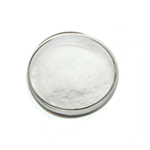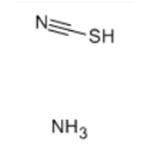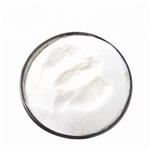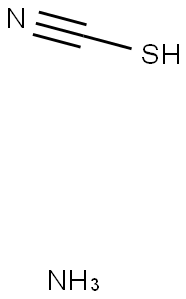Ammonium thiocyanate
- CAS No.
- 1762-95-4
- Chemical Name:
- Ammonium thiocyanate
- Synonyms
- AMMONIUM THIOCYANAT;Ammoniumrhodantate;AMMONIUM THIOCYANATE 0,1 MOL/L;NA-9092;rhodanid;trans-aid;AMITROLE-T;WEEDAZOLT-L;usafek-p-433;AMMONIUM THIOCY
- CBNumber:
- CB5853210
- Molecular Formula:
- CH4N2S
- Molecular Weight:
- 76.12
- MDL Number:
- MFCD00011428
- MOL File:
- 1762-95-4.mol
- MSDS File:
- SDS
| Melting point | 152-154 °C (lit.) |
|---|---|
| Boiling point | 262.85°C |
| Density | 1.3 |
| vapor pressure | <1 hPa (20 °C) |
| refractive index | 1.5300 (estimate) |
| Flash point | 190 °C |
| storage temp. | Store at +5°C to +30°C. |
| solubility | H2O: 1 M at 20 °C, clear, colorless |
| form | Solid |
| Specific Gravity | 1.305 |
| color | clear colorless or white |
| PH | 4.8-5.8 (50g/l, H2O, 20℃) |
| Odor | Odorless |
| PH Range | 4.5 - 6.0 |
| Water Solubility | 163 g/100 mL (20 ºC) |
| Sensitive | Light Sensitive & Hygroscopic |
| Merck | 14,561 |
| BRN | 3595135 |
| Exposure limits | NIOSH: IDLH 25 mg/m3 |
| Stability | Stable. Incompatible with strong acids, strong oxidizing agents. Forms explosive mixtures with lead nitrate. |
| LogP | 0.58 |
| Indirect Additives used in Food Contact Substances | AMMONIUM THIOCYANATE |
| FDA 21 CFR | 175.105 |
| CAS DataBase Reference | 1762-95-4(CAS DataBase Reference) |
| EWG's Food Scores | 1 |
| FDA UNII | YYL9152Z1Y |
| EPA Substance Registry System | Ammonium thiocyanate (1762-95-4) |
SAFETY
Risk and Safety Statements
| Symbol(GHS) |   GHS05,GHS07 |
|||||||||
|---|---|---|---|---|---|---|---|---|---|---|
| Signal word | Danger | |||||||||
| Hazard statements | H302+H312+H332-H318-H412 | |||||||||
| Precautionary statements | P273-P280-P301+P312-P302+P352+P312-P304+P340+P312-P305+P351+P338 | |||||||||
| Hazard Codes | Xn,Xi | |||||||||
| Risk Statements | 20/21/22-32-52/53-36/37/38 | |||||||||
| Safety Statements | 13-61-36/37-36-26-46 | |||||||||
| RIDADR | 9092 | |||||||||
| WGK Germany | 1 | |||||||||
| RTECS | XK7875000 | |||||||||
| F | 3 | |||||||||
| TSCA | Yes | |||||||||
| HS Code | 28380000 | |||||||||
| Toxicity | LD50 orally in Rabbit: 500 mg/kg | |||||||||
| NFPA 704 |
|
Ammonium thiocyanate price More Price(43)
| Manufacturer | Product number | Product description | CAS number | Packaging | Price | Updated | Buy |
|---|---|---|---|---|---|---|---|
| Sigma-Aldrich | 221988 | Ammonium thiocyanate ACS reagent, ≥97.5% | 1762-95-4 | 100g | $68.2 | 2024-03-01 | Buy |
| Sigma-Aldrich | 221988 | Ammonium thiocyanate ACS reagent, ≥97.5% | 1762-95-4 | 2.5kg | $889 | 2024-03-01 | Buy |
| Sigma-Aldrich | 1.09079 | Ammonium thiocyanate solution c(NH?SCN) = 0.1 mol/l (0.1 N) Titripur? Reag. Ph Eur,Reag. USP | 1762-95-4 | 1L | $41.1 | 2024-03-01 | Buy |
| Sigma-Aldrich | 1.01213 | Ammonium thiocyanate for analysis EMSURE? ACS,ISO,Reag. Ph Eur | 1762-95-4 | 500g | $272 | 2024-03-01 | Buy |
| Sigma-Aldrich | 1.01213 | Ammonium thiocyanate for analysis EMSURE? ACS,ISO,Reag. Ph Eur | 1762-95-4 | 25kg | $9770 | 2024-03-01 | Buy |
Ammonium thiocyanate Chemical Properties,Uses,Production
Outline
Ammonium thiocyanate is colorless lustrous monoclinic flaky or columnar crystal with the chemical formula being NH4SCN and the molecular weight of 76.12. At 92 ℃, it is rhombohedral crystal with the melting point of 147 ℃ (decompose at 170 ℃), the relative density of 1.3057 and the refractive index of 1.685. It is easily soluble in water and will have endothermic reaction when being dissolved in water. It is soluble in alcohol, alkali metal hydroxide, acetone, pyridine and liquid sulfur dioxide but insoluble in chloroform. Its solution exhibits red color upon exposure to sunlight.In case of ferric iron, it generates iron thiocyanate of blood red color and can be measured by colorimetric quantification according to the color of standard solution. When being heated to 140 ℃, it can generate Thiourea while it will be decomposed into ammonia, hydrogen sulfide and carbon disulfide at 176 ℃. It is easily to be deliquescent in the air and therefore should be sealed with isolation from acid. Production method: have carbon disulfide and ammonia in a pressurized reactor react for 20 hours at the temperature of 30 ℃ to obtain it; alternatively, have sulfur powder, sodium cyanide and ammonium chloride reacted with water with the temperature being maintained at 110 ℃ to obtain the final product. The main purposes: It can be used as the polymerization catalysts for organic synthesis, dyeing spreading agent, herbicide, analytical reagents such as for determination of mercury, silver as well as trace iron. It can also be used for the production of thiocyanate and thiocyanate complex salt. It also has certain dissolving capability for silver halide. Its concentrated solution has also the ability of dissolving the gelatin. It can also be used as photographic liquid and golden color matching of the printing paper, printing of cotton and steel pickling.
Industrial ammonium thiocyanate
The industrial ammonium thiocyanate is one of the purified products of coke oven gas. The pure product is colorless and shiny monoclinic crystal with the formula being NH4SCN and the density being 1.305g/cm3. It is easily deliquescent in air and is soluble in water (upon dissolving industrial ammonium thiocyanate, the production system is highly endothermic). It has a melting point of 149.6 ℃ and decomposition point of 170 ℃. Ammonium thiocyanate is mainly used in dyeing industry and can also be used as chemical reagent or preparation of herbicides. During the purification process of coke oven gas, adopting ammonium polysulfide solution for removing hydrogen cyanide from the oven gas can lead to the industrial ammonium thiocyanate product with the content being more than 92%.
The absorption reaction of decyanation of the coke oven gas is:
HCN + (NH4) 2Sn → HSCN + (NH4) 2Sn-1
NH3 + HSCN → NH4SCN
NH3 + HCN → NH4CN
NH4CN + (NH4) 2Sn → NH4SCN + (NH4) 2Sn-1
The ammonia involved in the absorption reaction comes from the coke oven gas itself, so the decyanation device must be in front of the procedure of ammonia recovery of coke oven gas. After the coke oven gas is subjecting to removal of tar mist and naphthalene through the electric tar precipitator, we should further use ammonium polysulfide solution for removing the hydrogen cyanide gas in the oven gas for generating ammonium thiocyanate.
The absorbing liquid is constantly circulating and washing the coal gas to increase the concentration of the ammonium thiocyanate contained in the absorption solution while continuously removing a portion of the absorbing liquid for adding sulfur for regeneration. The regeneration reaction formula is (NH4) 2Sn-1 + S → (NH4) 2Sn. When the content of the ammonium thiocyanate of the absorption liquid has reached 250g/L, you can take it out for sending for processing, after the process of evaporation and crystallization, you can produce the industrial product of ammonium thiocyanate.
thiocyanic acid
Thiocyanate has two isomers. The first one is thiocyanate H-S-C≡N, the other one is isothiocyanate H-N-C = S. Free acid has not been separated yet. Most of thiocyanate salt can be dissolved in water. SCN-ion is a good ligand. SCN-ion has a special and sensitive reaction of forming various kinds of red complex with Fe3 +. Therefore, potassium thiocyanate or ammonium thiocyanate can often be used as the reagent for analyzing Fe3+.
It is colorless, volatile liquid with slightly toxic. It has a melting point of-110 ℃ and is stable at 0 ℃. At room temperature, it can be subject to rapid decomposition at room temperature. It is highly water-soluble and its aqueous solution exhibits strongly acidic. Its thermal solution or concentrated solution is both easy to be broken and easy to be polymerized. At-90 ~-85 ℃, it can be polymerized into white crystals. In vacuum condition, it can be heated to form a pale yellow sulfur cyanuric acid which can be dissolved in diethyl ether. Then it is easily to be broken down into thiocyanate. It can be obtained through the reaction between potassium thiocyanate and potassium hydrogen sulfate or through putting the ammonium thiocyanate aqueous solution through H-cation exchange resin system. In laboratory, its salt can be used testing of iron and quantitative determination of silver reagents.
The above information is edited by the Chemicalbook of Dai Xiongfeng.
Potassium thiocyanate
Potassium thiocyanate is also known as "sulfur potassium cyanide." Its chemical formula is KSCN with a molecular weight of 97.18. It is colorless rhombic system crystal and has deliquescence. It is toxic and can irritate the skin. It has a melting point of 173.2 ℃ and the relative density of 1.88614. When the melt is cooled, it will change into brown, green, blue and white color. It is easily soluble in water with the aqueous solution being neutral. It is soluble in acetone, ethanol and liquid ammonia. It can subject to decomposition at 500 ℃. Method: potassium cyanide and sulfur powder were co-heated; alternatively, have ammonium thiocyanate and potassium hydroxide react to obtain it. Purposes: for the production of mustard oil, thio-urea, drugs; it can be used for the printing and dyeing industry, photography, and used as a refrigerant and analysis reagents.
Solubility in water (g / 100ml)
The amount (gram) dissolved per 100 ml of water at different temperatures (℃):
120g/0 ℃; 144g/10 ℃; 170g/20 ℃; 208g/30 ℃; 234g/40 ℃;346g/60 ℃.
Chemical Properties
It is colorless monoclinic flake or columnar crystals. It is shiny. It is easily soluble in water, ethanol, ammonia, acetone, pyridine and liquid sulfur dioxide.
Uses
It can be used as dyes and the polymerization catalysts for organic synthesis. It can also be used as pesticides of weeding and defoliants as well as antibiotics separation. It can also be used as the raw material for the manufacturing of cyanide and thiourea.
It can be used as the auxiliary materials of the manufacturing of hydrogen peroxide. It can also be also used in dyes, organic synthesis, pesticides, pharmaceuticals, etc.
It can also be used for zinc coating, dyeing spreading agent and electroplating additives.
It can be used as reagents for the analysis as well as for the separation of antibiotics.
It can be used for the verification and determination of trace iron and determination of silver and mercury. It can also be used as polymerization catalyst, for the separation of antibiotics, for pesticides content analysis, water analysis, and preparation of thiocyanate standard solution.
Production method
Carbon disulfide method: mix carbon disulfide and a slight excess amount of ammonia with water for reaction of about 20 h at a pressure of 5.88 × 105Pa and at a temperature of 100 ℃ for generating ammonium thiocyanate. The reaction solution was subject to evaporation under reduced pressure for removing the hydrogen sulfide. At a solution temperature of 105 ℃, use ammonium sulfide to remove iron and heavy metals, filter and have the filtrate concentrated under reduced pressure for cooling crystallization in the mold, and then have isolation through centrifugation, dying to obtain ammonium thiocyanate.
CS2 + 3NH3 → NH4SCN + NH4HS
NH4HS → NH3 ↑ + H2S ↑
Sulfur method: put proper amount of water and sulfur powder into the reactor and stir into a paste like status; add slowly graded solid sodium cyanide for reaction to obtain sulfur sodium cyanide at a temperature of about 110 ℃. Then further add solid ammonium chloride for the reaction to obtain sulfur ammonium cyanate. The reaction mixture was further added into barium thiocyanate; clear the impurities for clarification; the supernatant was evaporated under reduced pressure with concentration to precipitate out the sodium chloride; then filter, cool and crystallize, separate and dry to obtain ammonium thiocyanate.
NaCN + S → NaSCN
NaSCN + NH4Cl → NaCl + NH4SCN
Category
toxic substances
Toxicity grading
highly toxic
Acute toxicity
oral-rat LD50: 750 mg/kg; Oral-Mouse LD50: 500 mg/kg
Flammability and hazard characteristics
upon heating, it produces toxic nitrogen oxides, sulfur oxides, cyanide and ammonia fumes
Storage characteristics
Treasury: ventilation, low-temperature and dry; store it separately from potassium perchlorate
Extinguishing agent
Dry powder, foam, sand, carbon dioxide, water mist
Professional standards
STEL 5 mg/m3
Description
Ammonium thiocyanate is a colorless solid which absorbs moisture and becomes liquid. Molecularweight= 76.12; Boiling point= 115℃; Freezing/Meltingpoint=160℃, decomposes at 170℃; Heat of solution=3.1 3 105 J/kg. Hazard Identification (based on NFPA-704 M Rating System): Health 2, Flammability 1,Reactivity 1, Corrosive. Soluble in water.
Chemical Properties
colourless or white crystals or powder
Chemical Properties
Ammonium thiocyanate is a colorless solid which absorbs moisture, becoming liquid, known as the “liquor.”
Uses
Colorless deliquescent crystals made by boiling an aqueous solution of ammonium cyanide with sulfur or polysulfides. It must be kept in a well-sealed container. The principal use for ammonium thiocyanate was in gold-toning formulas, but it was also used in a 5 percent solution to dissolve gelatin in overexposed carbon prints.
Uses
Used as a determination of iron, mercury, and silver.
Uses
Applied in the formation of novel two-dimensional Cd-SCN coordination solids with unusual and tailorable, checkerboard- or herringbone-patterned structures these structures are important steps toward technologically useful materials.1
Uses
In matches; double-dyeing fabrics; photography; improving and increasing strength of silks weighted with tin salts; producing grayish-black coating on Zn; manufacture of transparent artificial resins, thiourea; in pesticides. Detection and determination of small quantities of Fe; determination of Ag, Hg, etc.
Production Methods
Ammonium thiocyanate (plus ammonium sulfide) [CAS: 12135-76-1] may be made by reaction of ammonia and carbon disulfide, a reaction which probably accounts for the presence of ammonium thiocyanate in the products of the destructive distillation of coal. This reaction corresponds to the formation of ammonium cyanate from ammonia and carbon dioxide.
Preparation
(NH4)2S is obtained from reacting hydrogen sulfide with excess of ammonia:
H2S + 2NH3 → (NH4)2S.
Definition
ammonium thiocyanate: A colourless, soluble crystalline compound,NH4NCS. It is made by theaction of hydrogen cyanide on ammoniumsulphide or from ammoniaand carbon disulphide in ethanol. Onheating, it turns into its isomerthiourea, SC(NH2)2. Its solutions givea characteristic blood-red colour withiron(III) compounds and so are employedas a test for ferric iron. Ammoniumthiocyanate is used as arapid fixative in photography and asan ingredient in making explosives.
General Description
Ammonium thiocyanate is a colorless crystalline solid. Ammonium thiocyanate is soluble in water. The primary hazard is the threat posed to the environment. Immediate steps should be taken to limit its spread to the environment. Ammonium thiocyanate is used in chemical analysis, in photography, as a fertilizer, and for many other uses.
Air & Water Reactions
Water soluble.
Reactivity Profile
Ammonium thiocyanate can release ammonia vapors if mixed with a chemical base or with an acid. Violent or explosive reactions have occurred when thiocyanates are mixed with oxidizing agents (such as chlorates(potassium chlorate), nitrates, nitric acid, and peroxides). Nitric acid violently oxidized a thiocyanate solution [Bretherick 1979 p. 121]. An explosion of guanidine nitrate demolished an autoclave built to withstand 50 atmospheres, in which Ammonium thiocyanate was being made from Ammonium thiocyanate and lead nitrate [C. Angew. Chem. 49:23 1936].
Health Hazard
Inhalation of dust causes irritation of nose and throat. Ingestion causes dizziness, cramps, nervous disturbances. Dust irritates eyes. Can be absorbed through skin; prolonged contact may produce various skin eruptions, dizziness, cramps, nausea, and mild to severe disturbance of the nervous system.
Fire Hazard
Special Hazards of Combustion Products: Decomposes to form ammonia, hydrogen sulfide, and hydrogen cyanide. Oxides of nitrogen may also form. All of these products are toxic.
Flammability and Explosibility
Non flammable
Safety Profile
Poison by ingestion and intraperitoneal routes. Human systemic effects by ingestion: hallucinations and distorted perceptions, nausea or vomiting, and other gastrointestinal effects. See also THIOCYANATES. When heated to decomposition it emits toxic fumes of NH3, NOx, SO,, and CN-. Incompatible with KClO3 and mixtures with Pb(NO3)2.
Potential Exposure
It has many uses in making matches, fabric processing; metals processing; chemical manufacturing, electroplating; zinc coating; liquid rocket propellents, fabric dyeing, polymerization catalyst, in photography. Used as a laboratory chemical. May be used as an agricultural chemical: herbicides, weed killers, defoliants.
First aid
If this chemical gets into the eyes, remove anycontact lenses at once and irrigate immediately for at least15 min, occasionally lifting upper and lower lids. Seekmedical attention immediately. If this chemical contacts theskin, remove contaminated clothing and wash immediatelywith soap and water. Seek medical attention immediately. Ifthis chemical has been inhaled, remove from exposure,begin rescue breathing (using universal precautions, including resuscitation mask) if breathing has stopped and CPR ifheart action has stopped. Transfer promptly to a medicalfacility. When this chemical has been swallowed, get medical attention. Give large quantities of water and inducevomiting. Do not make an unconscious person vomit.
storage
Color Code—White: Corrosive or Contact Hazard;Store separately in a corrosion-resistant location. Prior to nitrate, since violent reactions occur. Store in tightly closedcontainers in a cool, well-ventilated area away from moisture, acid, acid fumes, or chlorine because toxic fumes arereleased. Where possible, automatically pump liquid fromdrums or other storage containers to process containers.working with this chemical you should be trained on itsproper handling and storage. Ammonium thiocyanate mustbe stored to avoid contact with Potassium chlorate and Lead
Shipping
UN2672 Ammonia solutions, relative density between 0.880 and 0.957 at 15 C in water, with . 10 % but not . 35 % ammonia, Hazard class: 8; Labels: 8- Corrosive material. UN3082 Environmentally hazardous substances, liquid, n.o.s., Hazard class: 9; Labels: 9- Miscellaneous hazardous material, Technical Name Required. UN3077 Environmentally hazardous substances, solid, n.o.s., Hazard class: 9; Labels: 9-Miscellaneous hazardous material, Technical Name Required.
Purification Methods
Crystallise it three times from dilute HClO4 to give material optically transparent at wavelengths longer than 270nm. It has also been crystallised from absolute MeOH or from acetonitrile.
Incompatibilities
Incompatible with oxidizers (chlorates, nitrates, peroxides, permanganates, perchlorates, chlorine, bromine, fluorine, etc.); contact may cause fires or explosions. Keep away from alkaline materials, strong bases, strong acids, oxoacids, epoxides. Acts as an acid; incompatible with lead nitrate, chlorates, nitric acid, acid, acid fumes. In the presence of moisture, this chemical is corrosive to brass, copper, iron. Ammonium thiocyanate liquor can release ammonia vapors if mixed with a chemical base or with an acid. Violent or explosive reactions have occurred when thiocyanates are mixed with oxidizing agents . Nitric acid violently oxidized a thiocyanate solution . An explosion of guanidine nitrate demolished an autoclave built to withstand 50 atmospheres, in which it was being made from ammonium thiocyanate and lead nitrate .
Waste Disposal
Consult with environmental regulatory agencies for guidance on acceptable disposal practices. Generators of waste containing this contaminant (≥100 kg/mo) must conform with EPA regulations governing storage, transportation, treatment, and waste disposal. Slowly add to large container of water. Stir in slight excess of soda ash. Decant or siphon liquid from sludge, neutralize with HCl and flush to sewer. Sludge may be landfilled.
Ammonium thiocyanate Preparation Products And Raw materials
Raw materials
1of2
Preparation Products
1of7
| Supplier | Tel | Country | ProdList | Advantage | |
|---|---|---|---|---|---|
| ShanDong Look Chemical Co.,Ltd. | +8617653113219 | sales01@sdlookchemical.com | China | 2739 | 58 |
| Hebei Mojin Biotechnology Co., Ltd | +8613288715578 | sales@hbmojin.com | China | 12453 | 58 |
| Hebei Yanxi Chemical Co., Ltd. | +8617531190177 | peter@yan-xi.com | China | 5993 | 58 |
| Hebei Guanlang Biotechnology Co,.LTD | +8619930503252 | daisy@crovellbio.com | China | 5964 | 58 |
| Hebei Dangtong Import and export Co LTD | +8615632927689 | admin@hbdangtong.com | China | 991 | 58 |
| Henan Bao Enluo International TradeCo.,LTD | +86-17331933971 +86-17331933971 | deasea125996@gmail.com | China | 2503 | 58 |
| Henan Fengda Chemical Co., Ltd | +86-371-86557731 +86-13613820652 | info@fdachem.com | China | 7378 | 58 |
| Shandong Juchuang Chemical Co., LTD | +86-18885615001 +86-18885615001 | admin@juchuangchem.com | China | 387 | 58 |
| Henan Tianfu Chemical Co.,Ltd. | +86-0371-55170693 +86-19937530512 | info@tianfuchem.com | China | 21695 | 55 |
| Nanjing Finetech Chemical Co., Ltd. | 025-85710122 17714198479 | sales@fine-chemtech.com | CHINA | 885 | 55 |
View Lastest Price from Ammonium thiocyanate manufacturers
| Image | Update time | Product | Price | Min. Order | Purity | Supply Ability | Manufacturer | |
|---|---|---|---|---|---|---|---|---|
 |
2024-04-18 | Ammonium thiocyanate
1762-95-4
|
US $0.60 / kg | 10kg | 99% | 300tons | Hebei Dangtong Import and export Co LTD | |
 |
2024-04-18 | Ammonium thiocyanate
1762-95-4
|
US $850.00-770.00 / ton | 30ton | 99% | 8000ton | Hebei Dangtong Import and export Co LTD | |
 |
2024-03-15 | Ammonium thiocyanate
1762-95-4
|
US $63.00-34.00 / kg | 500kg | 99.9 | 200tons | Shandong Juchuang Chemical Co., LTD |
-

- Ammonium thiocyanate
1762-95-4
- US $0.60 / kg
- 99%
- Hebei Dangtong Import and export Co LTD
-

- Ammonium thiocyanate
1762-95-4
- US $850.00-770.00 / ton
- 99%
- Hebei Dangtong Import and export Co LTD
-

- Ammonium thiocyanate
1762-95-4
- US $63.00-34.00 / kg
- 99.9
- Shandong Juchuang Chemical Co., LTD
1762-95-4(Ammonium thiocyanate)Related Search:
1of4





